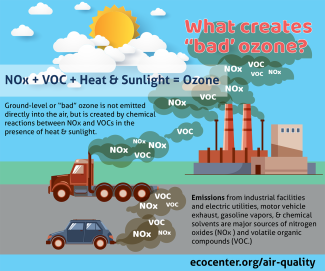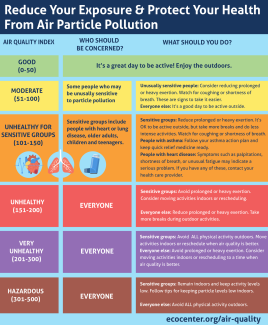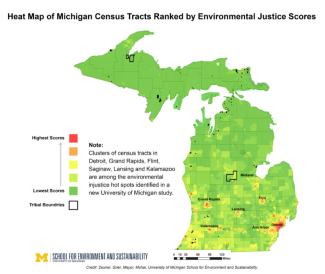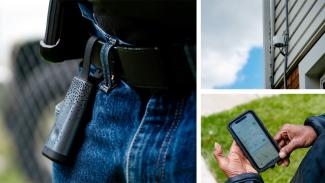By Swapna Nelaballi
Our earth’s atmosphere or ‘air’ is much more than just the oxygen we breathe. If you catapulted through it starting at the surface, you would travel through five unique layers before reaching outer space. This multi-layered shield protects, insulates, and sustains life on earth. The lowest, densest, and most chaotic layer of air, the troposphere, harbors all plant and animal life. It is the layer we call home.
So, what exactly is air? Simply put, it is a complex concoction of mostly gasses, varying amounts of water, and tiny solid particles or aerosols, held around the earth by gravity. Many of these elements occur naturally. But the air is also tainted with harmful elements known as pollutants or matter that is ‘out of place.’
Soot & Smog: The Deadly Duo
There are two types of pollutants. Primary pollutants are those that are directly released into the air from the source. Soot (also known as particulate matter) is the most prevalent primary pollutant in our air. It is made up of teeny-tiny particles released from burning fossil fuels. These microscopic airborne particles are especially dangerous, as they can penetrate the lungs and reach our bloodstream. This has severe implications for both respiratory and cardiovascular health, and in extreme cases, it causes premature death. Exposure to particulate matter also makes us more susceptible to new and emerging diseases like COVID-19.
The other type, secondary pollutants, form when primary pollutants intermingle. For instance, smog or “bad”/ground-level ozone is formed when sunlight reacts with emissions from burning fossil fuels, and with gasses released by certain hazardous chemicals (known as VOCs) found in gasoline, paints, and many cleaning solvents. The impacts of smog can range from eye and throat irritation to lung damage. Children, senior citizens, people who work or exercise outdoors, and people with asthma, allergies, or other pre-existing health conditions are particularly at risk.

Credit: Erica Bertram, The Ecology Center
AADL Summer Game Code: WECAIRABOUTIT
Death by Breath: Health Impacts of Air Pollution
Breathing in this toxic concoction takes a deadly toll, increasing our risk of disease and death. Exposure to primary and secondary pollutants has been linked to respiratory, heart, and skin diseases, dysfunction of our reproductive and central nervous system, and cancer. A recent study estimated that globally, soot (particulate matter) pollution alone causes more than 10 million premature deaths annually. To put this in perspective, as of August, 2022, the overall death toll from the novel Coronavirus is a little under 6.5 million. Another study identified pollution (including air pollution) as the ‘largest existential' threat to health. The study reports that between 2015 and 2019, pollution was responsible for 1 in 6 six deaths worldwide, and caused more deaths than war, terrorism, malaria, HIV, TB, drugs, and alcohol!
Air pollution is also a major threat to planetary health. Some pollutants from the air are deposited onto soil, vegetation, water bodies, and buildings among other surfaces, through acid rain leading to increased environmental contamination. Exposure to such toxins causes birth defects, reproductive failure, diseases in animals, and increases the susceptibility of domestic and wild plants to pests, pathogens, and other environmental stressors. Other air pollutants destroy the “good” ozone in the upper layer of our atmosphere, essentially perforating the shield that protects us from the sun’s harmful ultraviolet (UV) rays.
Making matters worse, air quality and climate change are engaged in a deadly dance, egging each other on. On one hand, the release of pollutants into the air changes our climate by affecting how much of the incoming sunlight is absorbed or reflected back. For example, ground-level ozone absorbs more sunlight, trapping heat, and thus warming the climate. Additionally, different types of particulate matter, whether airborne or settled, can have a warming or cooling effect on the climate. On the flip side, changes in climate worsen local air quality. Warmer temperatures, due to climate change, ramp up reactions between primary pollutants increasing levels of secondary pollutants (such as ground-level ozone) in the air.
So, the air is rife with toxins. But, how did they get there? Pollutants infiltrate our air in many ways. While natural causes such as wildfires, dust storms, volcanic eruptions, or even rotting plant and animal matter periodically release pollutants, the primary contributor to air pollution today is human activity. Our reliance on fossil fuels, heavy industry, and modern agriculture, among other factors, has led to substantial and (more notably) a steady release of pollutants into the air.
As is the case in other afflicted countries, in the US, air pollution is most concentrated in urban areas. Here, there are many primary sources of pollution (factories, power plants, automobiles, aircrafts, etc.). Additionally, the structural design of cities exacerbates the impact by preventing polluted air from spreading out. As a result, sights of city skylines smothered by a dense, murky layer of air or smog have become all too familiar.
Clean or Dirty? Tracking an Invisible, Silent Killer
On particularly smoggy days, it’s not hard to imagine the toll air pollution takes on our health and lives. But air pollution is not always obvious. When we look around, we do not typically see ‘air’ because our atmosphere is made up of mostly invisible elements. Similarly, most air pollutants operate in stealth mode, being invisible, colorless, odorless, and/or too small to be seen by the naked eye. Given this, how do we know if the air we are breathing is safe or not?
A nationwide monitoring network provides us with a general overview of things. Scientists at the United States Environmental Protection Agency (EPA), in collaboration with several federal and state agencies, use complex, very expensive sensors stationed at 4,000 locations across the country to track air pollution. These sensors record hourly or daily measurements of concentrations of six criteria pollutants.

Credit: Erica Bertram, The Ecology Center
Measurements from these sensors are compared against the National Ambient Air Quality Standards (NAAQS) or acceptable levels of harmful pollutants in our air. These standards are set by the EPA as mandated by the Clean Air Act (1970). Based on this, the air quality for a given area is assigned an air quality index (AQI) value; a value between 0 and 500 that falls in one of six categories. Each category represented by a specific color, indicates the level of risk to human health. Simply stated, the higher the AQI value, the greater the concentration of pollutants and the greater the health risk.

Credit: Erica Bertram, The Ecology Center
On the surface, 4,000 monitoring stations recording hourly or daily data may seem like we’ve covered all the bases. But, believe us, when we tell you that this is still grossly inadequate! With over 11,000 neighborhoods in the US, the available air quality data is good enough to determine broadscale trends, but it may not be an accurate representation of the air quality in your neighborhood.
Leave No One Behind: Need for Addressing Environmental Inequities
Neighborhood-level monitoring is important because the burden of air pollution is not evenly shared. Given a choice, no one wants to live next to a waste incinerator, a coal plant, an oil refinery, or any such noxious entity. Yet, millions of people do. People in these neighborhoods deal with higher exposure to pollutants and are impacted disproportionately more than others.
Historically, systems built on racist and discriminatory policies ensured that industries spewing toxic waste or choked highways were located far away from affluent white neighborhoods. More often than not, this means poor and working-class communities of color live in neighborhoods where the environment is loaded with pollutants. These communities, already overburdened by economic and health disparities, are among the most vulnerable to air pollution. Thus, monitoring air quality at the neighborhood-scale is not only a crucial public health measure, but this information is vital for educating and empowering communities who bear the brunt of the burden. However, monitoring at this scale is challenging in terms of both cost and effort.

The Ecology Center: Supporting and Empowering At-Risk Communities
To create healthy living conditions for all residents of Detroit, we at the Ecology Center have partnered with community members to address the challenge of neighborhood-level monitoring.
According to the American Lung Association's recent ‘State of the Air’ report, alarmingly, Detroit features on two separate lists of 25 most polluted US cities; those polluted by smog (#24) and those by soot (#16). Detroit neighborhoods, with multiple sources of pollution in addition to a large transportation sector, suffer some of the worst impacts of air pollution. Adults in Detroit are hospitalized for asthma 3.7 times as often as adults in the rest of the state. Children suffering from asthma visit the ER at least 3,300 times a year. Annually, soot and smog exposure cause ~660 premature deaths, half a million missed workdays, and a million missed school days. Beyond health impacts, air pollution is an expensive crisis, costing us ~6.5 billion USD every year!
In 2019, following decades of fighting systemic injustice, we successfully led the Breathe Free Detroit campaign, shutting down the Detroit waste incinerator. But the air in Detroit remains polluted from many other sources.
To understand where “hot-spots” of concern are currently located, we initiated a community-led air quality monitoring program. Community-based air quality monitoring is an essential tool for both awareness and advocacy. Such information is crucial to inform public policy so that emissions are cut at the source, and exposure is reduced through mitigative measures, be it improved air filtration in buildings, vegetative buffers, or campaigns compelling industries to adhere to regulatory norms.

Photo credit: Nick Hagen
To this end, we installed 27 low-cost “Purple Air” monitors that measure particulate matter and five “Clarity” monitors that measure particulate matter, ozone, and nitrogen dioxide, across the city. Additionally, in collaboration with neighborhood groups, we recruited and trained dozens of residents to wear portable “Flow2” monitors to record air quality on the go.
We are currently working out a system for managing data generated by all of our monitors to create a single integrated map, illustrating air quality for different neighborhoods in Detroit. Additionally, we are collaborating with community-based organizations to scale up this air quality monitoring system and develop tools to sustain and support it. The long-term vision of this work is to both increase awareness about the importance of clean air, and have better policies in place that will protect our health and save lives.


